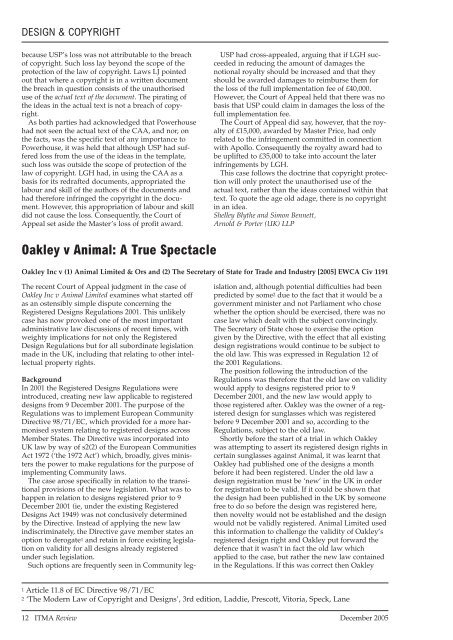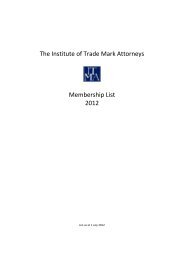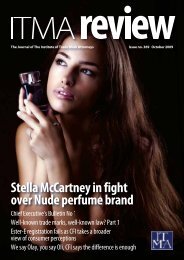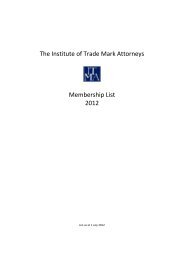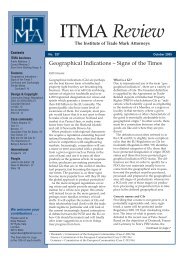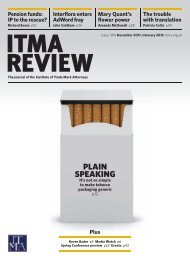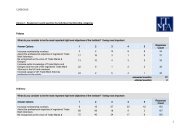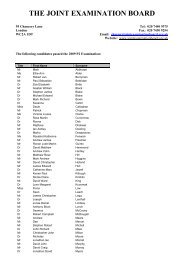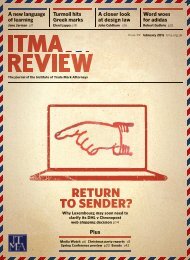ITMA 322 APRIL 2005
ITMA 322 APRIL 2005
ITMA 322 APRIL 2005
You also want an ePaper? Increase the reach of your titles
YUMPU automatically turns print PDFs into web optimized ePapers that Google loves.
DESIGN & COPYRIGHT<br />
because USP’s loss was not attributable to the breach<br />
of copyright. Such loss lay beyond the scope of the<br />
protection of the law of copyright. Laws LJ pointed<br />
out that where a copyright is in a written document<br />
the breach in question consists of the unauthorised<br />
use of the actual text of the document. The pirating of<br />
the ideas in the actual text is not a breach of copyright.<br />
As both parties had acknowledged that Powerhouse<br />
had not seen the actual text of the CAA, and nor, on<br />
the facts, was the specific text of any importance to<br />
Powerhouse, it was held that although USP had suffered<br />
loss from the use of the ideas in the template,<br />
such loss was outside the scope of protection of the<br />
law of copyright. LGH had, in using the CAA as a<br />
basis for its redrafted documents, appropriated the<br />
labour and skill of the authors of the documents and<br />
had therefore infringed the copyright in the document.<br />
However, this appropriation of labour and skill<br />
did not cause the loss. Consequently, the Court of<br />
Appeal set aside the Master’s loss of profit award.<br />
Oakley v Animal: A True Spectacle<br />
USP had cross-appealed, arguing that if LGH succeeded<br />
in reducing the amount of damages the<br />
notional royalty should be increased and that they<br />
should be awarded damages to reimburse them for<br />
the loss of the full implementation fee of £40,000.<br />
However, the Court of Appeal held that there was no<br />
basis that USP could claim in damages the loss of the<br />
full implementation fee.<br />
The Court of Appeal did say, however, that the royalty<br />
of £15,000, awarded by Master Price, had only<br />
related to the infringement committed in connection<br />
with Apollo. Consequently the royalty award had to<br />
be uplifted to £35,000 to take into account the later<br />
infringements by LGH.<br />
This case follows the doctrine that copyright protection<br />
will only protect the unauthorised use of the<br />
actual text, rather than the ideas contained within that<br />
text. To quote the age old adage, there is no copyright<br />
in an idea.<br />
Shelley Blythe and Simon Bennett,<br />
Arnold & Porter (UK) LLP<br />
Oakley Inc v (1) Animal Limited & Ors and (2) The Secretary of State for Trade and Industry [<strong>2005</strong>] EWCA Civ 1191<br />
The recent Court of Appeal judgment in the case of<br />
Oakley Inc v Animal Limited examines what started off<br />
as an ostensibly simple dispute concerning the<br />
Registered Designs Regulations 2001. This unlikely<br />
case has now provoked one of the most important<br />
administrative law discussions of recent times, with<br />
weighty implications for not only the Registered<br />
Design Regulations but for all subordinate legislation<br />
made in the UK, including that relating to other intellectual<br />
property rights.<br />
Background<br />
In 2001 the Registered Designs Regulations were<br />
introduced, creating new law applicable to registered<br />
designs from 9 December 2001. The purpose of the<br />
Regulations was to implement European Community<br />
Directive 98/71/EC, which provided for a more harmonised<br />
system relating to registered designs across<br />
Member States. The Directive was incorporated into<br />
UK law by way of s2(2) of the European Communities<br />
Act 1972 (‘the 1972 Act’) which, broadly, gives ministers<br />
the power to make regulations for the purpose of<br />
implementing Community laws.<br />
The case arose specifically in relation to the transitional<br />
provisions of the new legislation. What was to<br />
happen in relation to designs registered prior to 9<br />
December 2001 (ie, under the existing Registered<br />
Designs Act 1949) was not conclusively determined<br />
by the Directive. Instead of applying the new law<br />
indiscriminately, the Directive gave member states an<br />
option to derogate1 and retain in force existing legislation<br />
on validity for all designs already registered<br />
under such legislation.<br />
Such options are frequently seen in Community leg-<br />
islation and, although potential difficulties had been<br />
predicted by some2 due to the fact that it would be a<br />
government minister and not Parliament who chose<br />
whether the option should be exercised, there was no<br />
case law which dealt with the subject convincingly.<br />
The Secretary of State chose to exercise the option<br />
given by the Directive, with the effect that all existing<br />
design registrations would continue to be subject to<br />
the old law. This was expressed in Regulation 12 of<br />
the 2001 Regulations.<br />
The position following the introduction of the<br />
Regulations was therefore that the old law on validity<br />
would apply to designs registered prior to 9<br />
December 2001, and the new law would apply to<br />
those registered after. Oakley was the owner of a registered<br />
design for sunglasses which was registered<br />
before 9 December 2001 and so, according to the<br />
Regulations, subject to the old law.<br />
Shortly before the start of a trial in which Oakley<br />
was attempting to assert its registered design rights in<br />
certain sunglasses against Animal, it was learnt that<br />
Oakley had published one of the designs a month<br />
before it had been registered. Under the old law a<br />
design registration must be ‘new’ in the UK in order<br />
for registration to be valid. If it could be shown that<br />
the design had been published in the UK by someone<br />
free to do so before the design was registered here,<br />
then novelty would not be established and the design<br />
would not be validly registered. Animal Limited used<br />
this information to challenge the validity of Oakley’s<br />
registered design right and Oakley put forward the<br />
defence that it wasn’t in fact the old law which<br />
applied to the case, but rather the new law contained<br />
in the Regulations. If this was correct then Oakley<br />
1 Article 11.8 of EC Directive 98/71/EC<br />
2 ‘The Modern Law of Copyright and Designs’, 3rd edition, Laddie, Prescott, Vitoria, Speck, Lane<br />
12 <strong>ITMA</strong> Review December <strong>2005</strong>


